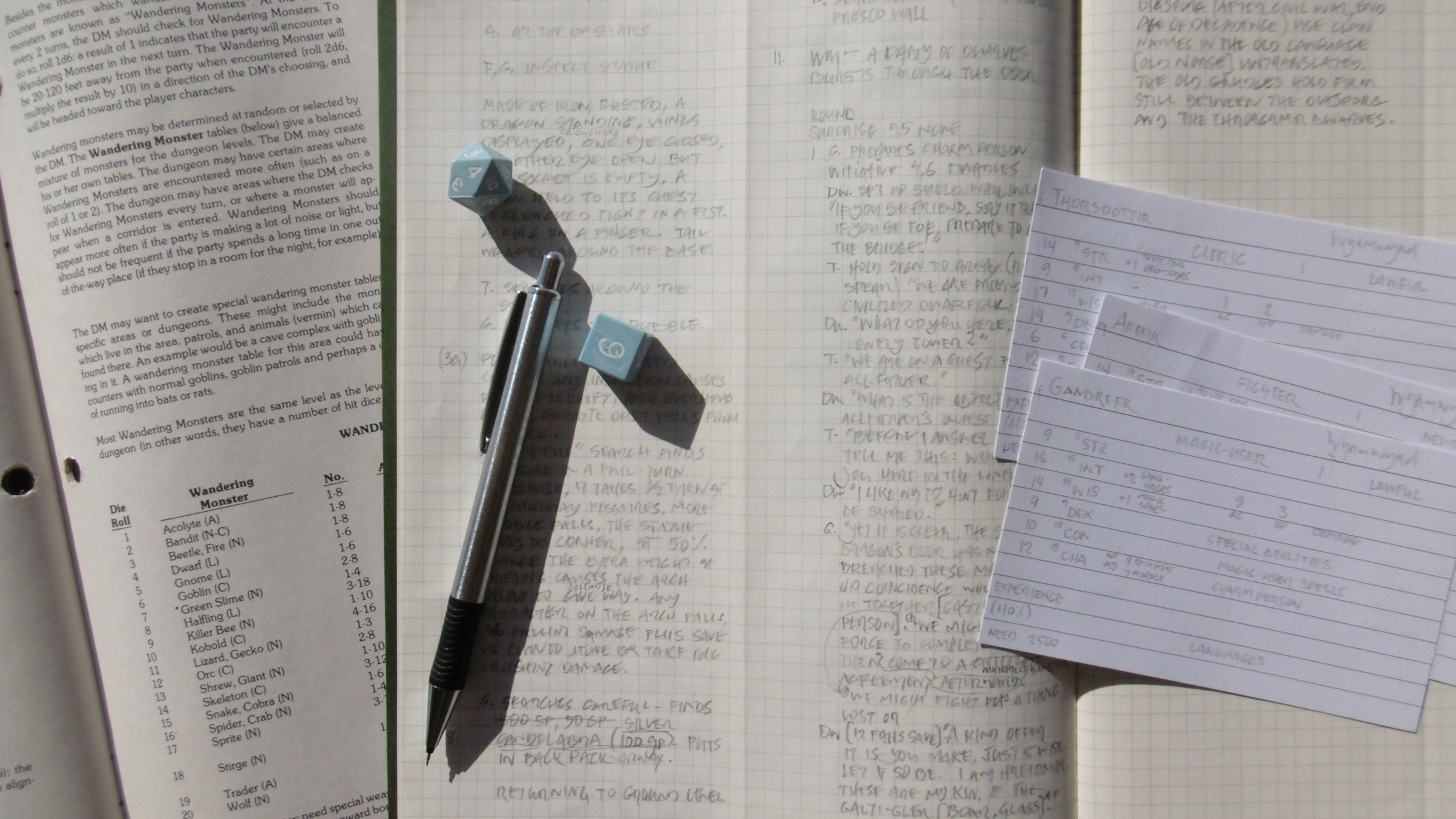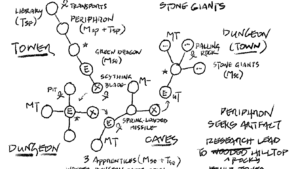
As a general rule in Wyrmwyrd, I use the Wandering Monsters tables (B53-54, X55-56) to generate random encounters.
Returning to the first floor, Ardur posted himself, spear in hand, on the entry landing with an ear to a door. Thorsdottir examined the central pillar and the stones underfoot, while Gandrefr searched the fresco wall. Both hoped to find a hidden entrance to the dungeon below mentioned in the parchment text. Neither found it before Ardur whispered a quick warning and readied the spear, facing the door.
When the doors burst open and a half dozen dwarves rushed through, Ardur held his ground. The dwarves formed a shield wall.*
One, peering over a shield, spoke: “If you be friend, say it true. If you be foe, prepare to cross the bridge!”1
Thorsdottir lowered her mace. “We are friends to civilized dwarfolk.”
“What do you here in Schlafender Drachenturm?”*
“We are on a quest.”
“And what is the object of your quest?”*
Thorsdottir hesitated. “Before I answer thrice, answer me once: What seek you here?”
“I like not to hint, for it cannot be shared.”†
Gandrefr stepped forward, empty palms raised. “Yet, it is clear,” she moved her hands while she spoke, “the sleeping dragon’s door has not been breached these many years. No coincidence would bring us together.” Her hands now traced a slow pattern in the air. “We might fight for a thing lost, or we might join our forces to find it. What say you?”
Behind the shield wall, there was much discussion and not a little grumbling. A moment later, the dwarf raised his head above the shield. “A kind offer it is you make, my friend, just and wise. Let it so be. I am Hreidmar. These are my kin of the Galti-Gler.”2
Monster Reactions in Role-Playing Encounters
When a monster’s action is not obvious, I rely on the Monster Reactions table (B24) to determine the flow of a role-playing encounter. In the encounter with Hreidmar and company, I knew the dwarves, like the player characters, were after the sword, but their attitude toward competition could go either way.
Rolling for reaction on entry and after Thorsdottir’s first two responses, I got three “Uncertain, monster confused” results in a row [marked with asterisks (*)]. With the dialog now established, I ignored any single result of 5 or less (attack possible or immediate), assuming “Uncertain,” while allowing two such results to indicate a bad turn in the discourse—an automatic “Hostile, possible attack.”
I did not roll for reaction to Thorsdottir’s inquiry about the dwarves’ goal [dagger (†)]. The polite question could not invoke a negative response but I didn’t imagine, either, that Hreidmar would give up the information to someone he didn’t trust.
At this point, Gandrefr interceded and threw a charm person spell on Hreidmar to banish doubt, barring a successful save, about his attitude. The dwarf leader might be in love.
Notes
*† The marked sentence or phrase is Hreidmar’s reaction to the player characters. See the section Monster Reactions in Role-Playing Encounters.
1 The dwarf refers to the bridge, which crosses a chasm to connect the mortal world to the underworld, whence one goes after death.
2 The Galti-Gler [galti (boar) + gler (glass)] is a diaspora clan. As the Throrgrmir Civilization fell into decline with the gold vein and gem mines played out and wyrmlings prowling the dungeon realm, the Galti-Gler returned to Forn Fjallaheim, their ancestral home. Hreidmar’s company is an adventuring party, following rumors of a magic sword lost in Schlafender Drachenturm.

Nice description of the Charm Person spell! I thought Gandrefr was making signs to indicate membership in a secret brotherhood to convince the dwarves they were friends (possibly as an alignment language), never suspecting it was actually a spell. I now see how that could be described in game in a way that might not trigger paranoia in the other party.
The use of How to Host a Dungeon for campaign background is also very inspiring, especially the naming conventions generated. I like this very much!
How to Host a Dungeon is extremely useful for many things. But the naming conventions are more simple: names are derived from real world languages, ancient and modern.